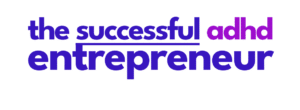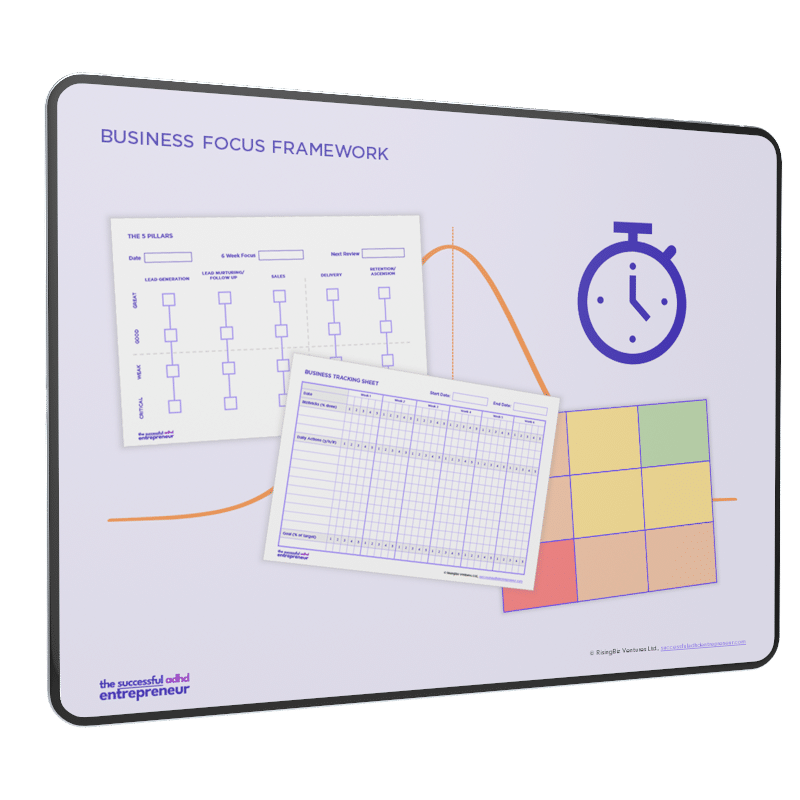How to beat time-blindness in ADHD: My 5 component-strategy

When someone asks you, what ADHD looks like, you probably mention forgetfulness or time-blindness as typical traits.
And you already know what’s next.
You hear: Yeah, me too.
(Hint: If you are one of those people saying this, please consider stopping it. It’s a conversation killer. And it’s wrong.)
So, I asked Mike, the one with ADHD in our business, how he assures that tasks he is responsible for getting done.
Here’s his answer …
My 5-component strategy to beat time-blindness in ADHD.
First, I need to tell you about the two kinds of tasks I refer to. The strategy depends on this distinction.
And – it is a significant first step to break out of the “everything is awful with ADHD” cycle.
#1 – Tasks with clear deadlines.
This is something like paying bills on time. Or a deadline from our accountant or the tax office.
When I went to college, it was a deadline from my professor. It was not always easy for me to do tasks with deadlines, but usually, I did them.
So, external deadlines work for me.
And this understanding was the first step to a better system and a way to beat time-blindness in ADHD – more often.
Understanding the pattern of time-blindness.
Try to observe which kind of work is more accessible or rarely forgotten by you. If you do that for several days, you will see a pattern.
Or ask friends or family what they think.
The reason for this step is simple:
When some tasks are easier done than others, not everything is lost. Something works, at least more often or easier. And that lowers the perception everything is hard with ADHD.
(Which is our philosophy in business: Build to your strength. Move on from that.)
#2 – Tasks without clear deadlines.
A lot went wrong in our business until we understood the nature of what I didn’t do: Recurring tasks, like Facebook, LinkedIn, shooting videos, writing blog posts.
You may think, you have a business partner, why can’t she do all the “boring-ADHD-stuff.” And Andrea is doing a lot of these.
But I still WANTED to do some of those things, but I couldn’t.
For a long time, our “system” went like this:
- Me promising to do the recurring-boring things (but not doing them for long).
- Andrea realized what had happened and called me out.
- Me becoming defensive-aggressive.
- Andrea became angry and thought about divorce … then we agreed … and the cycle started again.
No sustainable system.
Each day I promised myself I would do that tomorrow. Until one day, Andrea showed me from our meeting notes that not two weeks had passed as I thought.
Instead, nine months went by. N I N E months.
This is time-blindness at work. (And btw – since then, we have one iron rule: Everything must have a date. Try it; it works wonders.)
That’s why I came up with this system with five equally important components.
Uncertain what's important right now?
With our Business Focus Finder, it only takes 5 minutes to find out what you should work on in the next 6 weeks.
It also helps you to stay on track and cross the finish line - even if your ADHD causes you trouble with that.
Component No. 1: Connecting to emotions.
The first step to beat time-blindness in ADHD is establishing an emotional connection with my goal.
Why do I want to do that?
Generally speaking: It is not easy to keep the motivation high in long-term projects – ADHD or not. But with ADHD, it is more challenging because dopamine floats in the brain because of the different ways dopamine floats. (Let’s say for now it is slower.)
But what does dopamine do?
Dopamine is a neurotransmitter produced by the hypothalamus, a small region of the brain that helps you feel pleasure. It’s an important part in your reward system, meaning the brain releases dopamine when you do things that feel good or pleasurable or when you complete a task. Dopamine also helps with movement and motivation. (Source.)
The critical word in this description is “reward system.”
If you feel good, you do more of these things, called motivation. If nothing feels good, you stop, which is brilliant.
(The brain’s task is to protect our life, and not wasting energy could lead to death when a sabertoothed is chasing you; see how smart that is?)
When dopamine helps with movement and motivation and is slower in an ADHD brain, aren’t we screwed?
I don’t think so.
From 20+ years of coaching business owners, we know that the absence of ADHD is not a surefire recipe for a successful business.
But back to my system …
There are ways to boost dopamine, like completing simple tasks that make us feel good—or setting goals you can quickly achieve. Because once you reach that small goal, your reward system activates dopamine. Mission completed.
By making an emotional connection with my goal, I do exactly that.
Example of connecting to emotions:
I use LinkedIn to gain visibility for our new website and the successful ADHD entrepreneur business.
I knew I would be motivated just by starting this new project. Hello, dopamine! But it would decline soon.
Here is what I wrote:
I had ADHD all my life. And I didn’t know since 2014. Until then, a lot of bad things happened. Accidents, several job losses, struggles in relationships and our business – and the depleting feeling of not fulfilling my potential or getting to a point where I am proud of myself. Even for once.
I want that: I-did-it-feeling.
With this project, I can show other business owners with ADHD how to be successful. And how it’s possible to get ahead, even if it’s not easy, because I know how hard we had to fight in the beginning.
I know I will have to do hard things to reach my goals. And ultimately – I want to give back to Andrea because she suffered a lot and supported me in ways I can’t even describe in those 20+ years. […]
You see … that’s a lot of emotion for me.
Of course, there are additional ways to hack into our happy chemicals like food, exercise, lifestyle. But this is where it starts for me.
Let’s move to the second component.
Component No. 2: Connecting to values.
When I read Atomic Habits by James Clear, it hit me. I understood that living a particular life is not only about my goals for the future.
Because that always felt separated from me. It is there. And I’m here. How can I cross the gap?
Which ultimately leads to the question: Who do I want to be?
It’s less about the things necessary to get there, but how the person IS, at the core, who can do, what I want to do. When I know that, I know what to do, and then, I can break this goal down to daily activities.
My values operate as a GPS. They helped me stay on track and get back on track when I didn’t.
Check out the main ideas from this book in the description from Brian Johnson (20 min.):
After component #2, I move to the step many people are missing (and fail in business, even if they don’t have ADHD).
Component No. 3: Connecting with reality.
This step is all about ultra-specific planning. I made a tracking sheet when I started my LinkedIn “mission”.
It was not perfect, and I had to adjust it. I had text templates; I played with ways to structure the work and different times, days, etc.
This gave me a good starting point.
Component No. 4: Building habits.
Learning to not bs myself (and Andrea) about what will happen after the initial phase was critical. Because for a long time, I tried to rely on willpower. I told myself: This time, I’ll make it.
But willpower only goes so far.
Or, as Andrea says: If relying on willpower does not work for a neurotypical brain, we should not rely on it with ADHD.
Again, James Clear explains it very well. Just google “James Clear building habits,” and you find enough material.
Let’s move on to the fifth component.
Component No. 5: When the rubber hits the road …
Here we discuss what happens on those days when you think: I still don’t feel like it. And you know, these days will come.
There will be the days when this voice is whispering in your ear saying: Screw it, why bother …
Again, it’s not that people who don’t have ADHD experience this. And many of them fail to deal with it. I can’t tell you if it is more challenging with ADHD.
What I know is what works for me.
- My business is not the primary source of fun in my life. It is my job, just like my corporate job. I had to go to work, even if I was not in the mood. I had to do specific tasks, even if they seemed hard. With our business, it is the same. Some things are fun, some are “meh,” and some I would like to avoid, but I can’t.
- I use a technique from ACT called defusion. When that thought pops up and tells me to give up, I use the silly voice strategy (imitating Donald Duck), saying: Give up, give up, give up … give up. Or I say: Oh hi, you again, long time no see. You get the idea.
You can find more on the defusion technique in this video, 11 min.
The goal is to take back control because we are not our thoughts. We are not what we think, and we don’t have to act on it. We can choose. This will probably not work all the time 100%.
But that’s not what it’s all about. It’s about a solid frame to move ahead one step after the other.
This is what works for me – at least most of the time. Maybe you find some inspiration in it.
Summary
To beat time-blindness in ADHD, I start by connecting emotions to what I want to do. I continue by finding my values, which help me do things, even if they are sometimes challenging.
I use ultra-specific planning and tracking while deliberately building habits around the task. And I actively use defusion techniques to conquer the thought in my head, trying to convince me that it is not leading anywhere to do such ridiculously dull things.
What could you do now?
Hop to our Work Together page and see … how it would be to work together 😉
Read Fight Procrastination: What you need to know to win the battle
Or browse our Start Here page to see what we have to offer.
P.S. Whenever you're ready … here are three ways we can help you grow your business.
1. Watch our free video course, "The Business Focus Framework."
The shortcut to the most important tasks in your business that helps actually to follow through. It takes 5 minutes to find out what to work on for the next 6 weeks. – Click here.
2. Increase your close rate up to 84% (free guide).This short guide helps you have successful conversations with customers without being pushy or salesy, even if you think you are not good at selling. - Click here.
3. Work with us 1:1.
If you are curious how working with us looks like, hop on the "Work Together" page. And if it speaks to you, schedule your Discover the Possibilities Call by emailing me: I want that! To andrea@successfuladhdentrepreneur.com, and I’ll send you a link to our automated scheduling system.


